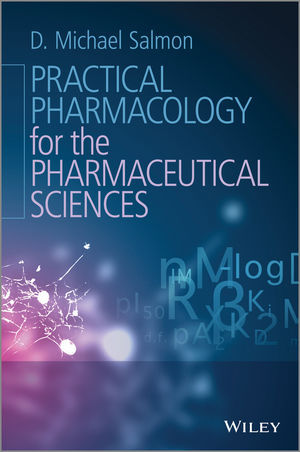
Practical Pharmacology for the Pharmaceutical Sciences - D. Michael Salmon

Descripción
Descripción completa de: Practical Pharmacology for the Pharmaceutical Sciences - D. Michael Salmon
Author : D. Michael Salmon
Language: English
Finishing : Paperback, 210 pages
ISBN : 978-1-119-97550-2
Edition Number: 2014
Description:
Practical Pharmacology for the Pharmaceutical Sciences is a lab survival guide for those studying Pharmacology, providing hands-on advice on developing pharmacology laboratory and data handling skills. Suitable for both undergraduates and postgraduates, it focuses on laboratory techniques rather than computer-simulated data. It also guides the reader through the process of communicating experimental results in a variety of formats, including posters, oral presentations and project reports.
Split into three main areas, the following topics are covered in detail:
Preparation for Experimental Pharmacology
- Legal aspects
- Fundamentals of Pharmacology
- Definitions, calculations and statistics
Experiments in Pharmacology
- Microtitre-based techniques using isolated cells
- In vitro techniques using isolated tissues and organs
- Biochemical techniques using cell-free systems
Communicating experimental results
- Data presentation
- How to write scientific reports
- Pharmacological literature
Supported with numerous questions throughout the text, as well as step by step instructions for practical experiments, this book presents an approach to learning pharmacology through an appreciation of authentic experimental data.
Table Of Contents:
- Preface ix
- Acknowledgements xi
1 Before Entering the Pharmacology Laboratory 1
- 1.1 Safety and Risk Assessment 1
- 1.2 The Laboratory Record Book 3
- 1.3 Use of Animals in Practical Pharmacology 4
- 1.4 Experimental Design 5
- 1.5 Units, Dilutions and Logarithms 7
- 1.5.1 Units of Mass 8
- 1.5.2 Units, Concentrations and Logarithms 8
- 1.5.3 Dilutions 9
- 1.5.4 Logarithms 10
- 1.6 Essential Statistics 12
- 1.6.1 Continuous Data – t-test, ANOVA, Non-parametric Tests and Regression 12
- 1.6.2 Discontinuous Data – X2 and Fisher's Exact Test 21
2 Basic Pharmacological Principles 27
- 2.1 Drug–Receptor Interaction 27
- 2.1.1 Agonists 27
- 2.1.2 Antagonists 30
- 2.1.3 Receptor Classification 36
- 2.2 Bioassays 37
- 2.2.1 Single-point Assays 38
- 2.2.2 Bracketing Assays, Three-point or 2×1 Assays 38
- 2.2.3 Multi-point Assays, Such As Four-point or 2×2 Assays 39
3 Isolated Tissues and Organs 43
- 3.1 Equipment for In Vitro Experiments 44
- 3.2 Organ Baths 45
- 3.3 Physiological Salt Solutions 46
- 3.4 Transducers 47
- 3.5 Recording Equipment and Software 49
- 3.6 Dosing 50
- 3.7 Electrically Stimulated Preparations 52
- 3.8 Fault-Finding of In Vitro Isolated Tissue Preparations 53
4 Smooth Muscle Preparations 55
- 4.1 Gastrointestinal Smooth Muscle Preparations 55
- 4.2 Guinea Pig Isolated Ileum 56
- 4.2.1 Concentration–Response Curves for Cholinesters 57
- 4.2.2 Selective Antagonism 59
- 4.2.3 Specificity of Blood Cholinesterases 62
- 4.2.4 Quantification of the Potency of an Antagonist 64
- 4.2.5 Bioassays 67
- 4.2.6 Calcium Channel Blockers 73
- 4.2.7 Field-stimulated Guinea Pig Isolated Ileum 76
- 4.3 Rabbit Isolated Jejunum and the Finkleman Preparation 78
- 4.3.1 Adrenoceptor Sub-types 79
- 4.4 Isolated Tracheal Rings 80
- 4.5 Isolated Vas Deferens 82
5 Cardiovascular Preparations 93
- 5.1 Isolated Perfused Heart Preparations 94
- 5.1.1 The Langendorff Preparation 95
- 5.1.2 Cardiac Interactions of Anti-asthma Drugs 98
- 5.1.3 The Rat Isolated Auricle Preparation 99
- 5.2 Thoracic Aorta Preparation 102
- 5.2.1 Drugs Regulating Nitric Oxide-mediated
6 Skeletal Muscle 107
- 6.1 Types of Skeletal Muscle 107
- 6.2 Multiply-Innervated Skeletal Muscle Preparations 108
- 6.2.1 Agonists and Antagonists Acting on the Frog Rectus Abdominis 109
- 6.2.2 Action of Anticholinesterases on the Dorsal Muscle of the Leech 111
- 6.3 Focally Innervated Skeletal Muscle Preparations 116
- 6.3.1 The Frog Gastrocnemius Muscle–Sciatic Nerve Preparation 119
7 Isolated Cells 121
- 7.1 Freshly Isolated and Cultured Cells 121
- 7.1.1 Advantages of Isolated Cells 121
- 7.1.2 Cultured Cells 122
- 7.1.3 Cell Counting 122
- 7.2 Platelets 125
- 7.2.1 Inhibition of Aggregation by Nitric Oxide Donors 127
- 7.3 Neutrophils 131
- 7.3.1 Measurement of NADPH Cytochrome c Reductase 132
- 7.3.2 Measurement of Intracellular [Ca2+] 134
8 Biochemical Pharmacology 141
- 8.1 Pharmacological Applications of Common Biochemical Techniques 141
- 8.2 Enzyme Inhibitors 142
- 8.3 Acetylcholinesterase Inhibitors 143
- 8.4 Monoamine Oxidase Inhibitors 145
- 8.4.1 Sub-cellular Distribution of MAO Activity 146
- 8.4.2 Specificity of MAO Inhibitors for Isoenzymes 149
- 8.5 Thrombin Inhibitors 151
- 8.6 ATPase Inhibitors 155
9 Complementary Methods for Teaching Practical Pharmacology 161
- 9.1 The Comparative Merits of Available Methods 161
- 9.2 Interpretation of Experimental Data 162
- 9.2.1 Behavioural Experiments 162
- 9.2.2 Analysis of Metabolites of 5-hydroxytryptamine 166
- 9.2.3 Radioligand Binding 167
10 Communicating Results 177
- 10.1 Preliminary Reports 177
- 10.1.1 Tables 178
- 10.1.2 Graphs 178
- 10.1.3 Bar Graphs 179
- 10.1.4 Preliminary Conclusions 179
- 10.2 Poster Presentations 180
- 10.3 Oral Presentations 181
- 10.4 Project Reports 183
- 10.5 Pharmacological Literature 184
- 10.6 How to Cite Scientific Information Sources 187
- 10.7 Plagiarism 188
- References 188
- Appendix 1: Molecular Weights of Commonly Used Drugs 189
- Appendix 2: Useful Resources for Practical Pharmacology 191
- Index 193
Puedes encontrar este libro tambien en las siguientes categorías

































Valoración: